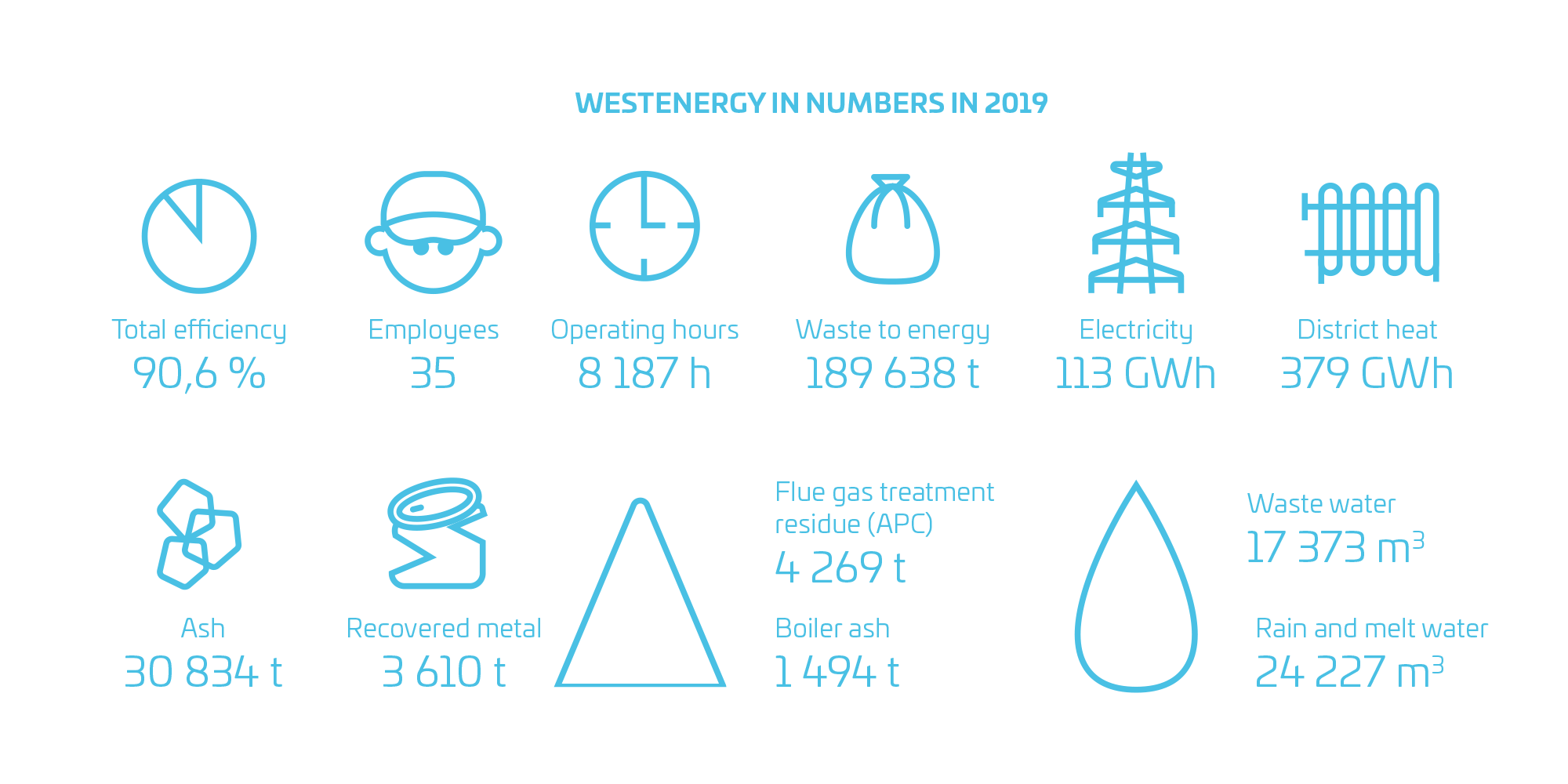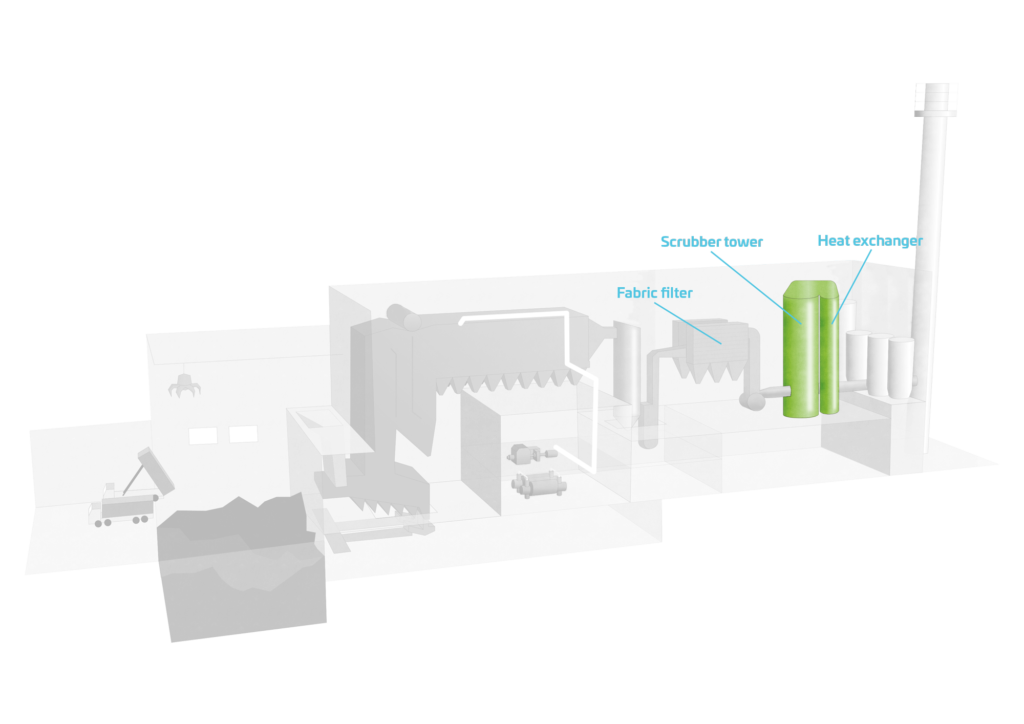


More energy, cleaner flue gases
Year 2019 was a successful one as a record amount of district heat was produced in Westenergy’s WtE plant (379 gigawatt-hours). “The new record is strongly linked to the flue gas scrubber that was taken into use at the end of the year, and the project largely defined the year in production as the alteration work necessary for the flue gas scrubber started already at the beginning of the year”, explains Westenergy’s Production Manager Kai Alavillamo who had the main responsibility in the project. The scrubber has proved out to be a successful investment as soon as it was taken into use, the levels of impurities in the flue gases dropped significantly and the district heat output of the plant increased by some 10 megawatts.
The same amount of fuel creates now more energy than before.
”Flue gas purification was very efficient already before the scrubber was taken into use but the scrubber adds the finishing touch to the purification. The scrubber reduces especially the levels of acidic impurities to the level that is necessary for the upcoming emission requirements. Moreover, as the same amount of fuel creates now more energy than before, the energy efficiency of the plant has improved significantly.”, Alavillamo sums up. The weather and time of the year seem to influence the output of the scrubber as the weather affects the temperature of the district heat return water. “It would seem that a mild winter is actually the optimal weather to utilise the heat recovery of the flue gas scrubber.”, Alavillamo explains.

Because of the flue gas scrubber, the plant’s process control involves more adjusting and observing the chemicals and pH levels, and here, there is still room for development. In addition to the flue gas scrubber, a power increase of the boiler was carried out last year, and the steam production was increased by about 10 percent. Because of the power increase, the district heat output of the plant increased by 4 megawatts. Several alterations to the equipment and steam lines preceded the power increase and its effects were inspected in the service stop in November. No significant erosion was detected so the plant is operated with the power increase in the future. The power increase and flue gas scrubber brought changes into the process control and the process cannot be controlled in the same way as before. “Last year a lot of big changes were carried out in the plant in a relatively short time so next year we focus on operating the plant as efficiently and smoothly as possible.”, Alavillamo continues.
The power increase and scrubber raise the district heat output of Westenergy’s plant by some 14 megawatts. Westenergy’s role as the local district heat producer has, therefore, become more crucial and Westenergy produces now about half of the district heat needed in the Vaasa region. Moreover, Westenergy’s plant produced 96 gigawatt-hours of electricity to the national grid which covers the annual need of some 10 000 households.
How does the flue gas scrubber work?
Most of the impurities in the flue gases are removed already in the semi-dry purification system that consists of injecting activated carbon and lime, and the fabric filter. Those impurities that remain in the flue gases after the semi-dry purification process are purified in the scrubber.
The flue gas scrubber consists of two main parts – scrubber tower and heat exchanger. There are two levels in the scrubber tower: on the lower level, ammonia and chlorides are removed, and on the upper level, sulphur dioxide is removed by adjusting the pH level in the flue gases. In the scrubber, the impurities in the flue gases dissolve in the water that is led to the furnace. The impurities are then collected in the semi-dry purification system.
In the heat exchanger that follows the scrubber, the thermal energy in the flue gases is recovered. In the condenser, the moisture in the flue gases becomes condensate water. The condensate is cooled down and purified with the help of sand filter and reverse osmosis so that is meets the quality requirements of tap water.
A large part of the condensate water is utilised in the scrubber and other processes of the plant, and the rest is led to the sewage system. The aim is to utilise the condensate water efficiently, and in the future, it is used to produce additional water to the district heating network.


Aiming at high availability
Westenergy’s main goal regarding the plant’s maintenance is clear: to create the prerequisites for high availability. At Westenergy, Maintenance Manager, Electrician, Automation Mechanic and three Mechanics form the maintenance team that takes care of the maintenance of the plant. In 2019, the plant’s availability rate was very high, about 94 percent.
“The maintenance of the plant is largely determined by the preventive maintenance plan, and in addition, those maintenance needs and tasks that require a plant shut-down are listed during the year. The to-do list for maintenance gets, therefore, longer when the service stop is nearing. Last year the service stop of the plant was more comprehensive than previous years as in addition to the usual service and maintenance tasks, the new flue gas scrubber was installed in the plant.”, explains Westenergy’s Maintenance Manager Rauno Tuokkola.
In 2019, the availability of the plant was very high, 94 percent.
The range of maintenance tasks is wide. Last year, the conveyors of the semi-dry purification system were replaced with new ones and a new, more effective fan was installed to the primary air feed. The shut-off valves in the bottom slag outlet system were changed into safer and more user-friendly. This helps solve disruptions more safely without shutting the plant down. In the spring, a smaller reduction valve was installed beside the old one, making it possible to by-pass the turbine more efficiently. In addition, related to the power increase, different alteration work was carried out. For instance, the safety valve was replaced because of the increase in the steam flow. In addition, thousands of different preventive maintenance work and basic repair work are carried out in the plant every year.
Cost-efficient operation is also a central goal for maintenance. “The plant has reached that age that different revisions have become necessary especially to those pieces of equipment that are in direct contact with material flows. We aim to predict the maintenance needs of the plant and plan the procedures in advance so that costs remain stable. Moreover, one of the goals in maintenance is to carry out most of the work with the help of our own staff.”, Tuokkola explains. In 2020 no significant investments are going to be carried out but the aim is to focus on making the plant run smoothly, efficiently and safely.